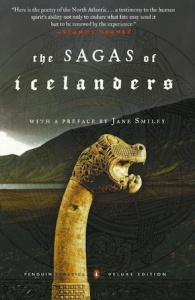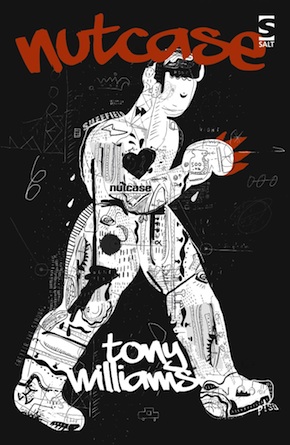Learning from the masters
by Tony WilliamsForget thrillers. Forget horror. Forget (forgive me) crime, and historical novels, and all the rest. For me, if you want a page-turner, Icelandic sagas are where it’s at.
Sagas are the novels of the medieval world. By which I mean, as prose narratives go, they’re miles ahead of anything else being written in medieval Europe: all those turgid chronicles, baffling letters, and impenetrable religious visions. The sagas are something else – clear, pacy, gripping, artful, funny and moving. In fact the sagas beat most novels into a cocked hat.
I’d dabbled over the years, but I really took the plunge about five years ago. In quick succession, I read most of the most famous sagas: Egil’s Saga, Njal’s Saga, The Saga of the People of Laxardal, the sagas of the outlaws Gisli Sursson and Grettir Asmundarson, and so on and so forth. I read through the various Penguin Classics editions and the (excellent) selected Sagas of Icelanders, and splashed out a few hundred quid on the five-volume complete translation of all the extant sagas. (We’re talking sagas of Icelanders here, also known as family sagas – there are other subgenres of saga I’ve barely scratched the surface of.) I hoovered them up, these odd tales about the lives of Norse farmers a thousand years ago.
And they are odd. Reading them takes some getting used to. There’s a lot of family history to get through, and a lot of repetition. Unlike a novel, where we might expect something like a narrative arc, a saga usually repeats the same kind of events over and over, with small variations. It can get a bit wearing, but it’s also moreish, and my typical reaction on finishing one saga is to reach for the next. Because for all their strangeness the sagas are brilliant at delivering narrative. They record the lives of tenth-century farmers and the blood feuds that damaged their communities and in a funny kind of way sustained them too. They’re the most muscular tales: shorn of detail and description, uninterested in exploring characters’ thoughts and feelings, they reel off their events and consequences – cause and effect – in a way which is quite breathtaking. What they lose in texture, they gain in scope and power. When (spoiler alert) the aged Njal lies down to die in his burning house, with his wife Bergþóra alongside him and their adoptive grandson lying between them, we know that this has come about in spite of Njal’s wisdom and diplomacy, and that his acceptance of his fate is entirely in keeping with his character over many years. And the horror and pity of this scene is not diminished but enhanced by the austere brevity of its narration.
What comes out of reading the sagas is how they are not like novels as much as they are like them. There are trolls and ghosts mixed in with the daily lives of farmers, so that they are neither ‘realist’ nor ‘fantasy’ but both together.”
The sagas are like novels in their artfulness, their awareness of how to feed and manipulate a reader’s thirst for story. But they are also like novels in their interest in people: above all, they show us communities trying and failing to live together happily, shaped by larger forces, and doomed to suffer the consequences of their own actions. And yet – they’re not novels, and in reading them as such, we look at them reductively. What comes out of reading the sagas is how they are not like novels as much as they are like them. There are trolls and ghosts mixed in with the daily lives of farmers, so that they are neither ‘realist’ nor ‘fantasy’ but both together. And the helter-skelter pace and lack of focus on their characters’ inner lives can take some getting used to. So we end up either reading against the sagas, trying to ignore the ways they challenge or puzzle us, or – and this is what I found myself doing – we start to wonder what the sagas can teach us, can teach the novel, about stories.
 That was the starting point for my novel Nutcase. I began to wonder how a modern novel could learn from the sagas, what would happen if I wrote a novel in the style of a saga – not a fantasy novel or a Viking tale but a story of contemporary life that learns from the anonymous saga authors of the thirteenth and fourteenth centuries.
That was the starting point for my novel Nutcase. I began to wonder how a modern novel could learn from the sagas, what would happen if I wrote a novel in the style of a saga – not a fantasy novel or a Viking tale but a story of contemporary life that learns from the anonymous saga authors of the thirteenth and fourteenth centuries.
The novel is based on a specific saga, The Saga of Grettir the Strong. But instead of the Norse warrior, I wrote about Aidan, a young vigilante growing up on a rough estate in Sheffield. Partly it was a case of replacing axes with Stanley knives, and ponies with Subaru Imprezas. But it was also more complicated than that. The sagas are full of violence, and they depict a world in which violence is an accepted part of life and of the legal process. That meant I had to find a modern setting where all that violence would be believable. I couldn’t have the police turning up in chapter one and killing the story dead. So I set my retelling in a world I had seen something of; certain disadvantaged communities of Sheffield which perhaps had their own values, sometimes at odds with those of the police and society at large, and which might try to deal internally with problems without asking for outside help. Working on all that taught me a few things: how hard it is to adapt a medieval text, but also how beautifully the saga-writing art was configured to depict the society of the saga age. Whether or not it makes sense to write sagas nowadays, I don’t know, but I do know that the saga writers have a lot to teach us, and that what they wrote all those centuries ago is still a hell of a read.
 Tony Williams’s lived in Sheffield for more than a decade before moving to rural Northumberland. He teaches English & Creative Writing at Northumbria University in Newcastle-upon-Tyne. His story collection All the Bananas I’ve Never Eaten (Salt Publishing, 2012) won the Saboteur Award, and his poetry collection The Corner of Arundel Lane and Charles Street and The Midlands (2009) was shortlisted for the Portico Prize. Nutcase, his first novel, is out now from Salt Publishing, priced £8.99.
Tony Williams’s lived in Sheffield for more than a decade before moving to rural Northumberland. He teaches English & Creative Writing at Northumbria University in Newcastle-upon-Tyne. His story collection All the Bananas I’ve Never Eaten (Salt Publishing, 2012) won the Saboteur Award, and his poetry collection The Corner of Arundel Lane and Charles Street and The Midlands (2009) was shortlisted for the Portico Prize. Nutcase, his first novel, is out now from Salt Publishing, priced £8.99.
Read more
writingresearchnorthumbria.wordpress.com
@TonyWilliams9


